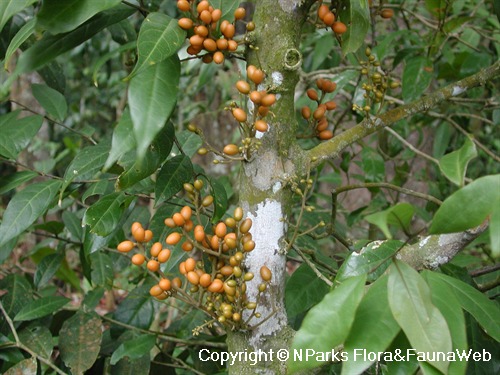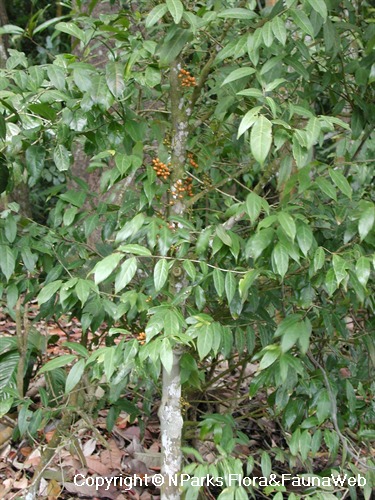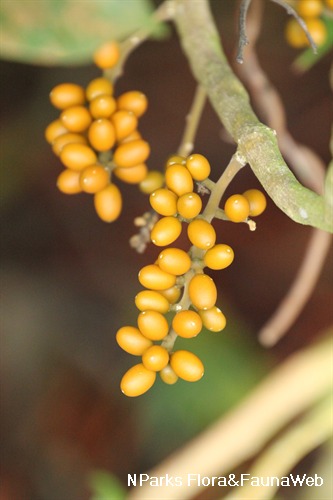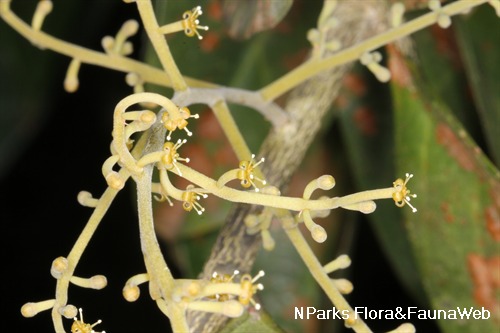.jpg)
Back
Champereia manillana (Blume) Merr.
| Family Name: | Opiliaceae |
| Synonyms: | Champereia griffithii Planch. ex Kurz |
| Common Name: | False Olive, Chemperai, Cheperi, Cimpri, Cipreh, Pokok kucing-kucing, 台湾山柚子 |
Name
Classifications and Characteristics
| Plant Division | Angiosperms (Flowering Seed Plants) (Dicotyledon) |
|---|---|
| Plant Growth Form | Tree (Medium (16m-30m)), Shrub |
| Lifespan (in Singapore) | Perennial |
| Mode of Nutrition | Autotrophic |
| Plant Shape | Irregular |
| Maximum Height | 4 m to 20 m |
Biogeography
| Native Distribution | Andamans and Southeast Asia to Taiwan, throughout Malesia to northwest New Guinea |
|---|---|
| Native Habitat | Terrestrial (Primary Rainforest, Secondary Rainforest, Monsoon Forest, Freshwater Swamp Forest) |
| Preferred Climate Zone | Tropical, Sub-Tropical / Monsoonal |
| Local Conservation Status | Native to Singapore (Least Concern (LC)) |
Description and Ethnobotany
| Growth Form | It is a tree or shrub, usually about 4–8 m tall, sometimes reaching 20 m. Its flowers grow on the stem and trunk. |
|---|---|
| Foliage | Its alternate, stalked leaves have fleshy or leathery leaf blades that are egg-shaped, oblong or lance-shaped, and about 4.5–25 by 1.5–11 cm. The leaf blades are hairless on both surfaces. |
| Flowers | Its flowering shoots are solitary or in groups of 2–4, up to 20 cm long. The shoots bear both unisexual and bisexual flowers. The unisexual flowers are green, whereas the bisexual flowers are yellowish-green. |
| Fruit | Its fruits are orange-red drupes that are 8–15 by 7–9 mm. |
| Habitat | It grows in primary and secondary evergreen forests or dry monsoon forests, up to 1,600 m altitude. |
| Associated Fauna | Its flowers are insect-pollinated. Its fruits and seeds are eaten and dispersed by birds. |
| Cultivation | It can be propagated by seed. |
| Etymology | Champereia, from the Malay name cemperai for this species. Latin manillana, of Manila, probably referring to one of the localities in the natural distribution of this species. |
| Ethnobotanical Uses | Edible Plant Parts : Edible Fruits, Edible Leaves Medicinal: A poultice made from the leaves and roots is administered for ulcers, whereas the boiled root is applied for rheumatism. |
Landscaping Features
| Landscaping | It may be suitable for parks and gardens. |
|---|---|
| Desirable Plant Features | Ornamental Fruits |
| Landscape Uses | General, Parks & Gardens, Small Gardens |
Fauna, Pollination and Dispersal
| Fauna Pollination Dispersal Associated Fauna | Bird-Attracting Plant (Fruits) |
|---|---|
| Pollination Method(s) | Biotic (Fauna) |
| Seed or Spore Dispersal | Biotic (Fauna) |
Plant Care and Propagation
| Light Preference | Semi-Shade, Full Sun |
|---|---|
| Water Preference | Moderate Water |
| Plant Growth Rate | Moderate |
| Rootzone Tolerance | Moist Soils, Well-Drained Soils |
| Propagation Method | Seed |
Foliar
| Foliage Retention | Evergreen |
|---|---|
| Mature Foliage Colour(s) | Green |
| Mature Foliage Texture(s) | Leathery |
| Foliar Type | Simple / Unifoliate |
| Foliar Arrangement Along Stem | Alternate |
| Foliar Attachment to Stem | Petiolate |
| Foliar Shape(s) | Non-Palm Foliage (Elliptical) |
| Foliar Venation | Pinnate / Net |
| Foliar Margin | Entire |
| Leaf Area Index (LAI) for Green Plot Ratio | 3.0 (Tree - Intermediate Canopy) |
Floral (Angiosperm)
| Flower & Plant Sexuality | Unisexual & Bisexual Flowers(Sub-dioecious) |
| Flower Colour(s) | Green |
|---|---|
| Flower Grouping | Cluster / Inflorescence |
| Flower Location | Axillary |
Fruit, Seed and Spore
| Mature Fruit Colour(s) | Orange, Red |
|---|---|
| Fruit Classification | Simple Fruit |
| Fruit Type | Fleshy Fruit , Non-Accessory Fruit |
Image Repository
Others
| Master ID | 1508 |
|---|---|
| Species ID | 2801 |
| Flora Disclaimer | The information in this website has been compiled from reliable sources, such as reference works on medicinal plants. It is not a substitute for medical advice or treatment and NParks does not purport to provide any medical advice. Readers should always consult his/her physician before using or consuming a plant for medicinal purposes. |

.jpg)



